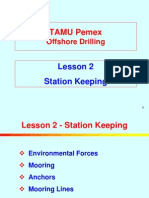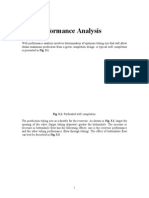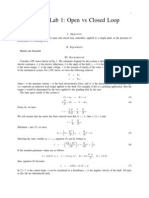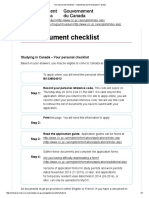0 ratings0% found this document useful (0 votes)
186 viewsAssignment No. 4-2013 PDF
Assignment No. 4-2013 PDF
Uploaded by
Leillane BeatrizThis document contains an assignment for an introduction to petroleum engineering course. It includes three problems: 1) describing primary production drive mechanisms and reservoir energies, 2) calculating relative permeabilities from coreflood data and defining critical properties, and 3) deriving equations for radial flow and average permeability and plotting well productivity curves for different skin factors.
Copyright:
Attribution Non-Commercial (BY-NC)
Available Formats
Download as PDF, TXT or read online from Scribd
Assignment No. 4-2013 PDF
Assignment No. 4-2013 PDF
Uploaded by
Leillane Beatriz0 ratings0% found this document useful (0 votes)
186 views1 pageThis document contains an assignment for an introduction to petroleum engineering course. It includes three problems: 1) describing primary production drive mechanisms and reservoir energies, 2) calculating relative permeabilities from coreflood data and defining critical properties, and 3) deriving equations for radial flow and average permeability and plotting well productivity curves for different skin factors.
Original Description:
vfc
Original Title
Assignment No. 4-2013.pdf
Copyright
© Attribution Non-Commercial (BY-NC)
Available Formats
PDF, TXT or read online from Scribd
Share this document
Did you find this document useful?
Is this content inappropriate?
This document contains an assignment for an introduction to petroleum engineering course. It includes three problems: 1) describing primary production drive mechanisms and reservoir energies, 2) calculating relative permeabilities from coreflood data and defining critical properties, and 3) deriving equations for radial flow and average permeability and plotting well productivity curves for different skin factors.
Copyright:
Attribution Non-Commercial (BY-NC)
Available Formats
Download as PDF, TXT or read online from Scribd
Download as pdf or txt
0 ratings0% found this document useful (0 votes)
186 views1 pageAssignment No. 4-2013 PDF
Assignment No. 4-2013 PDF
Uploaded by
Leillane BeatrizThis document contains an assignment for an introduction to petroleum engineering course. It includes three problems: 1) describing primary production drive mechanisms and reservoir energies, 2) calculating relative permeabilities from coreflood data and defining critical properties, and 3) deriving equations for radial flow and average permeability and plotting well productivity curves for different skin factors.
Copyright:
Attribution Non-Commercial (BY-NC)
Available Formats
Download as PDF, TXT or read online from Scribd
Download as pdf or txt
You are on page 1of 1
ENPE 241 Introduction to Petroleum Engineering
Assignment No. 4: Fall 2013
Due Date: 2:00 PM on November 8, 2013
1. Describe four major types of drive mechanisms for primary production and state the dominant
reservoir energy in each type of the drive mechanisms.
2. If the flow rates are measured at 100% saturation and the other saturations, respectively, no
other details about a core plug is needed for calculating relative permeabilities. Table 1 shows the
oil and water flow rates at the corresponding water saturation in a steady-state experiment.
1) Calculate the relative permeability for the oil-water system and plot the oil and water relative
permeabilities versus water saturation.
2) Define the critical water saturation, residual oil saturation on the relative permeability curve.
3) Is this a water-wet or oil-wet system? Provide your justification.
Table 1 Steady-state coreflooding experiment results.
S
w
q
o
(cm
3
/s) q
w
(cm
3
/s)
0.00 0.063 0.000
0.15 0.042 0.000
0.30 0.030 0.010
0.40 0.020 0.020
0.50 0.013 0.032
0.60 0.008 0.045
0.70 0.003 0.060
0.80 0.001 0.078
0.85 0.000 0.088
1.00 0.000 0.330
3. Figure 1 shows n beds or flow rings in series for a radial flow system. Each bed i has inner
and outer radii,
i
r and
1 + i
r (
w
r r =
0
,
e n
r r = ) and a permeability
i
k .
1) Derive the radial flow equation with skin effect.
2) Derive the following formula for the average permeability of the system without skin effect:
Figure 1 Radial flow through permeable beds in series.
3) With the above average permeability, draw the well IPR curves for skin factors equal to -5, 0, 5,
respectively. Use a drainage radius, ft r
e
2980 = (A=640 acres), ft r 200
1
= , and ft r 1800
2
= ,
mD k 3 . 9
1
= , mD k 3 . 23
2
= , and mD k 6 . 21
3
=
Data: psi p
e
6452 = , STB bbl res B / 23 . 1 = , s Pa =
3
10 5 . 1 , ft h 40 = , and ft r
w
328 . 0 = .
|
|
.
|
\
|
|
|
.
|
\
|
=
n
i i
i
i
w
e
avg
k
r
r
r
r
k
1
1
ln
ln
You might also like
- Lecture 4 - Simulation of Recycle StreamsDocument57 pagesLecture 4 - Simulation of Recycle StreamsKin Wai Cheah75% (4)
- ENPE 241-Review PDFDocument6 pagesENPE 241-Review PDFLeillane BeatrizNo ratings yet
- Cyclosim SingleDocument8 pagesCyclosim SingleEmiliano GilNo ratings yet
- Capstone For February 2021 DEWA Course #8 (Prof. M Akiharju)Document5 pagesCapstone For February 2021 DEWA Course #8 (Prof. M Akiharju)Daniyal AsifNo ratings yet
- Bi Kip Vo CongDocument7 pagesBi Kip Vo CongDonald VasquezNo ratings yet
- Cyclosim SingleDocument10 pagesCyclosim SingleRolando QuispeNo ratings yet
- RG 2020Document20 pagesRG 2020Vikash ShuklaNo ratings yet
- Cyclosim SingleDocument9 pagesCyclosim SinglehadryanaNo ratings yet
- Current Sensor Fault Detection by Bilinear Observer For A Doubly Fed Induction GeneratorDocument6 pagesCurrent Sensor Fault Detection by Bilinear Observer For A Doubly Fed Induction Generatorkatiki216No ratings yet
- Scope:: About The Cyclosim - Single Spreadsheet ..Document14 pagesScope:: About The Cyclosim - Single Spreadsheet ..Flia Diaz ZunigaNo ratings yet
- VISCOSITY CORRELATION Woelflin 1942 LooseDocument4 pagesVISCOSITY CORRELATION Woelflin 1942 Loosebilal AminNo ratings yet
- ACME - Spool Valve Leakage BehaviourDocument9 pagesACME - Spool Valve Leakage BehaviourUros GordicNo ratings yet
- Exercises On Fluid Flow in HC ReservoirsDocument3 pagesExercises On Fluid Flow in HC ReservoirsMohamed SahnounNo ratings yet
- B. E./B. Tech. Degree Examination, November/De C EMBER 2007Document0 pagesB. E./B. Tech. Degree Examination, November/De C EMBER 2007ekanthamoorthyNo ratings yet
- Mechanical Dewatering of SuspensionDocument7 pagesMechanical Dewatering of SuspensionAgung Prasetya ChandranenaNo ratings yet
- StatorDocument6 pagesStatorVishal SalveNo ratings yet
- Steady-State Analyses of Fluid Flow Characteristics For AFWS in PWR Using Simplified CFD MethodsDocument4 pagesSteady-State Analyses of Fluid Flow Characteristics For AFWS in PWR Using Simplified CFD MethodsViswanathan DamodaranNo ratings yet
- Station KeepingDocument67 pagesStation KeepingSagar MhatreNo ratings yet
- 1991 - Control of An Underwater Vehicle Using H SynthesisDocument6 pages1991 - Control of An Underwater Vehicle Using H Synthesissrirampavan.24phd7033No ratings yet
- Centrifugal Compressor Map Prediction and Modification - NewDocument16 pagesCentrifugal Compressor Map Prediction and Modification - Newpreetham108No ratings yet
- Two Stage Electro-Hydraulic Servo ValveDocument4 pagesTwo Stage Electro-Hydraulic Servo ValveabhijitmukhNo ratings yet
- Cyclosim SingleDocument12 pagesCyclosim SingleAch_The_KingNo ratings yet
- Performance of Three Turbulence ModDocument12 pagesPerformance of Three Turbulence Modkanbur.191No ratings yet
- Automatic Control ExerciseDocument140 pagesAutomatic Control Exercisetaile1995No ratings yet
- Well Completion and Stimulation - Chapter 3 Well Performance Analysis-NewDocument56 pagesWell Completion and Stimulation - Chapter 3 Well Performance Analysis-NewsouthliNo ratings yet
- Experiment 8 - Falling Sphere Viscometer ExperimentDocument5 pagesExperiment 8 - Falling Sphere Viscometer ExperimentAhmed NabilNo ratings yet
- U ManometersDocument28 pagesU ManometersGözde SalkıçNo ratings yet
- Los Alamos Scientific Laboratory: Title: A Computational F4 Thod Forfreesurface Hydrodyr AmicsDocument23 pagesLos Alamos Scientific Laboratory: Title: A Computational F4 Thod Forfreesurface Hydrodyr AmicsPrabaddh RiddhagniNo ratings yet
- Technical Note: S. Szvmgo and I. P. W. SillitoeDocument7 pagesTechnical Note: S. Szvmgo and I. P. W. SillitoeMohamed GamalNo ratings yet
- (Rronl' C 'Sevy : : S / - U. An-4444Document2 pages(Rronl' C 'Sevy : : S / - U. An-4444Shah PatelNo ratings yet
- Nonideal Flow in Reactors: - AnswerDocument26 pagesNonideal Flow in Reactors: - AnswerJoseph OrteneroNo ratings yet
- Pickett PlotDocument7 pagesPickett PlottasaddaqYounasNo ratings yet
- Orifice Prelim 2Document14 pagesOrifice Prelim 2Kyle NguyenNo ratings yet
- Building Blocks of MachineDocument7 pagesBuilding Blocks of MachineDeepak SahNo ratings yet
- The Optimisation of Flotation Networks: International Journal of Mineral ProcessingDocument21 pagesThe Optimisation of Flotation Networks: International Journal of Mineral ProcessingAli HassanzadehNo ratings yet
- Daly Of: University California, Los Alamos Scientific Laboratory, Los Alamos, New MexicoDocument32 pagesDaly Of: University California, Los Alamos Scientific Laboratory, Los Alamos, New MexicobarnamalaNo ratings yet
- Modeling of The Modified Quadruple-Tank Process: A. Numsomran, V. Tipsuwanporn, K. TirasesthDocument6 pagesModeling of The Modified Quadruple-Tank Process: A. Numsomran, V. Tipsuwanporn, K. Tirasesthanon_369320474No ratings yet
- Problem Sheet 4Document1 pageProblem Sheet 4rohanNo ratings yet
- Assignment Report SubmissionDocument15 pagesAssignment Report SubmissionZhen ChenNo ratings yet
- Morrell SAGDocument13 pagesMorrell SAGEigen Galvez100% (1)
- Numerical Simulation of PCV ValveDocument5 pagesNumerical Simulation of PCV Valve11751175No ratings yet
- Vasconcellos Et Al 6pagesDocument6 pagesVasconcellos Et Al 6pagessepid123No ratings yet
- Comparison of A Networks-of-Zones Fluid Mixing Model For A Baffled Stirred Vessel With Three-Dimensional Electrical Resistance TomographyDocument30 pagesComparison of A Networks-of-Zones Fluid Mixing Model For A Baffled Stirred Vessel With Three-Dimensional Electrical Resistance TomographyGian Carlos Perea DiazNo ratings yet
- EE132 Lab1 OL Vs CLDocument3 pagesEE132 Lab1 OL Vs CLthinkberry22No ratings yet
- An Adaptive Fuzzy Pid Control of Hydro-Turbine Governor: Xiao-Ying Zhang, Ming-Guang ZhangDocument5 pagesAn Adaptive Fuzzy Pid Control of Hydro-Turbine Governor: Xiao-Ying Zhang, Ming-Guang ZhangPadmo PadmundonoNo ratings yet
- Computation of Turbulent Jets in Annular Counter FlowDocument8 pagesComputation of Turbulent Jets in Annular Counter FlowKaffelNo ratings yet
- CIVL2104 2024 MAYDocument5 pagesCIVL2104 2024 MAYs15101No ratings yet
- Problemas Bono para Tercer Examen de Estadística - Verano 2012Document8 pagesProblemas Bono para Tercer Examen de Estadística - Verano 2012David Meza CarbajalNo ratings yet
- Band Control - Concepts and Application in Dampening OscillationsDocument6 pagesBand Control - Concepts and Application in Dampening OscillationsduhgrandoNo ratings yet
- Lateral Natural Frequency of A Shaft Rotor System by The Transfer Matrix MethodDocument14 pagesLateral Natural Frequency of A Shaft Rotor System by The Transfer Matrix Methodcarlfelipe100% (1)
- Analytical Modeling of Solute Transport in Groundwater: Using Models to Understand the Effect of Natural Processes on Contaminant Fate and TransportFrom EverandAnalytical Modeling of Solute Transport in Groundwater: Using Models to Understand the Effect of Natural Processes on Contaminant Fate and TransportNo ratings yet
- Reviews in Computational Chemistry, Volume 31From EverandReviews in Computational Chemistry, Volume 31Abby L. ParrillNo ratings yet
- Control of DC Motor Using Different Control StrategiesFrom EverandControl of DC Motor Using Different Control StrategiesNo ratings yet
- Reservoir Engineering in Modern Oilfields: Vertical, Deviated, Horizontal and Multilateral Well SystemsFrom EverandReservoir Engineering in Modern Oilfields: Vertical, Deviated, Horizontal and Multilateral Well SystemsNo ratings yet
- Classical Approach to Constrained and Unconstrained Molecular DynamicsFrom EverandClassical Approach to Constrained and Unconstrained Molecular DynamicsNo ratings yet
- Modern Borehole Analytics: Annular Flow, Hole Cleaning, and Pressure ControlFrom EverandModern Borehole Analytics: Annular Flow, Hole Cleaning, and Pressure ControlNo ratings yet
- Wedding CakesDocument4 pagesWedding CakesLeillane BeatrizNo ratings yet
- Wedding PackagesDocument5 pagesWedding PackagesLeillane BeatrizNo ratings yet
- Your Document Checklist - Citizenship and Immigration CanadaDocument3 pagesYour Document Checklist - Citizenship and Immigration CanadaLeillane BeatrizNo ratings yet
- Ethical Conduct Disclosure and Declaration Form - OK - PRINTDocument4 pagesEthical Conduct Disclosure and Declaration Form - OK - PRINTLeillane BeatrizNo ratings yet
- Steady Laminar Flow Between Fixed Parallel Plates: Lecture 20, TAM335 AL1, Prof. Min Feng Yu, Oct 11, 2010FDocument11 pagesSteady Laminar Flow Between Fixed Parallel Plates: Lecture 20, TAM335 AL1, Prof. Min Feng Yu, Oct 11, 2010FLeillane BeatrizNo ratings yet
- REE IffusionDocument38 pagesREE IffusionLeillane BeatrizNo ratings yet
- CAPP Statistical Handbook (2010 Data)Document215 pagesCAPP Statistical Handbook (2010 Data)hitm357No ratings yet
- Saskatchewan Student CertificationDocument2 pagesSaskatchewan Student CertificationLeillane BeatrizNo ratings yet




































































